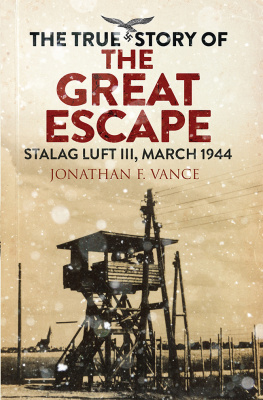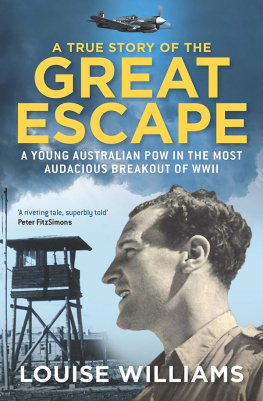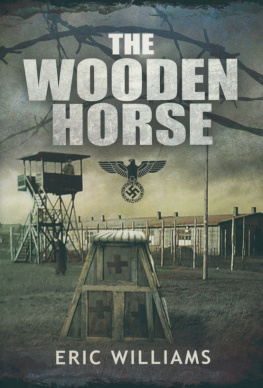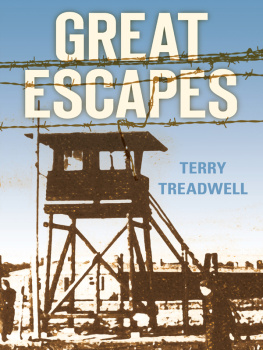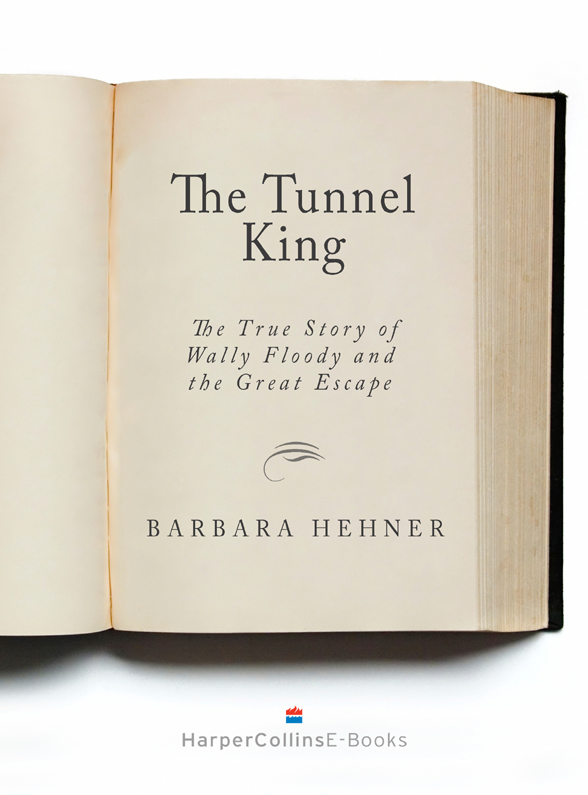Wally Floody lay on his side, propped up painfully on one elbow. He was in a 2-foot-square space, so cramped that he could not turn around. His only light came from a small tin filled with melted margarine and a wick made from pyjama cord. The lamp flickered and stank, and coated his mouth and throat with oily soot. But the lamp had to stay. Even the bravest tunneller could not bear the thought of working in complete darkness.
Behind Wally were 20 feet of tunnel, shored up (reinforced) with boards to keep the walls and ceiling from collapsing. Just above his head was unshored sandtons of it. But the veteran tunneller wouldnt let himself think about that. Instead, he concentrated on the wall of yellow sand just in front of his face. He hacked at it with his knife, then pushed the sand back to Hank Birkland, his digging partner. Hank picked up the sand with a scoop cut from a milk can. When his wooden box was full, Hank tugged on the rope tied to the box. Two men waiting at the tunnel mouth hauled the box back.
Wally heard a hissing sound just above his ear, as if a snake was dangling there. He knew what it was and backed up frantically. Behind him, Hank was also scrambling. Then, wet and cold and stinking, the roof came down on Wally. He tried to hold a little space around his face with his hands, but in seconds the sand was packing his nostrils and his mouth. He felt someone tugging on his legs and then he blacked out.
When Wally came to, gagging and spluttering, he was in the room carved out at the mouth of the tunnel. The men who manned the air pump and packed the sand in bags were looking on with concern. Hank and Wally stared at each other. They saw the filthy, torn longjohns both of them were wearing, their matted hair sticking in all directions, their eyes round and panicked in their grimy facesand started to laugh.
Flight Lieutenant Wally Floody was 25 years old, with dark hair and hazel eyes. He had been tall and lean to begin with. Prisoner-of-war rations, combined with the hard labour of digging tunnels, had left him gaunt and hollow-eyed. He had been buried alive several times before this and had felt the terror of suffocation. Once the lamp had spilled hot oil against his thigh as the roof caved in, so he had been burned as well as choked. But by 1943, he had been a prisoner of war in Germany for two years, and he wanted more than anything to escape. The best way out of Stalag Luft III, a prison camp for airmen, seemed to be a tunnel under the barbed-wire fence. Wally knew how to build tunnelsso he would go back down tomorrow, and the next day, and he would keep digging.
Chapter 1
LOOKING FOR ADVENTURE
Clarke Wallace Chant Floody was born in Chatham, Ontario, on April 28, 1918. When he was a year old, his family moved to Toronto, where Wallys father, William Edward, went to work in magazine publishing. Wallys younger sister, Catherine, was born soon after the move.
As he grew up, Wally was always the tallest boy in his class. His long arms and legs were thin, even though he had a hearty appetite. His mother believed he burned off everything he ate because he was rarely still. In the summers, he went to a sleep-over camp on the Toronto Islands. He also spent part of each summer on a farm in Clinton, Ontario, where his mother had relatives. He helped to look after the livestock and he learned to ride a horse. However, he always returned to Toronto in time for the Ex, the Canadian National Exhibition. His Clinton cousins often came with him.
On Young Canada Day at the exhibition, admission for kids was free and the rides and games cost only a nickel apiece. Wally, Catherine and their cousins joined thousands of other children swarming through the Princes Gates. First, they headed for the Pure Food Building, where they could stuff themselves with free food samples. Then it was over to the midway. No matter how high the Ferris wheel climbed, or how fast the roller coaster dropped, Wally always wished they went higher and faster.
Wally began high school at Northern Vocational in the fall of 1932. By grade 11, he was well over 6 feet tall, and active in team sports, especially basketball and football. As one of the junior football teams starting halfbacks, Wally had his picture taken by a newspaper photographer. It was an exciting day in the Floody house when the picture was published, and Catherine pasted it in her scrapbook. As soon as the football season ended, basketball practice began. Wally was the starting centre on Northerns junior basketball team, and its second leading scorer.
In 1935, Wally was in grade 12 and old enough to join Northerns senior teams. The Northern senior football team took the city championship that year. Wally played in the championship game at Varsity Stadium, the biggest stadium in the city. Nearly 10,000 people came to watch, including sports reporters from all three Toronto newspapers. The next day, Northern students paraded through the school neighbourhood, carrying Wally and the other football heroes on their shoulders.
Although Wally loved playing sports, he was bored and restless in class. By springtime of grade 12, he wanted to leave school. His marks were slipping badly. Besides, in 1936 Canada was suffering through the Great Depression. Many people all across the country had lost their jobs. Wallys father was still working, but he was not making as much money as he used to. Wally was now 18 years old. If he could find a job, he could help out with the familys income.
Through his fathers contacts in the publishing business, Wally got a job selling advertising for the Toronto Star. But he missed being outdoors, and he missed being able to play sports. Then he heard about a job that sounded much more exciting than selling adsand it paid better, too. The gold mines in Northern Ontario were hiring young men who were good athletes. Not only would they be given jobs in the mines, but they would also get to play on company sports teams. Games in the intermine leagues were hotly contested, and mine owners competed with each other to sign up the best players they could find.
In June of 1936, Wally got on a train and headed north. That summer, he worked at the Preston East Dome Mine in Timmins, Ontario. He played baseball on the company team, though it was not his best sport. He spent the fall and winter back at his job with the Toronto Star, but in May of 1937, he headed north once again. This time he went to Kirkland Lake, and took a job with the Lake Shore Mines.
Wally worked as a mucker, shovelling the mud and rock that had been blasted out of the ground, and loading it into carts so it could be hauled up to the surface. A person needed strong muscles to be a mucker and Wally was strong. It was hard work, but it paid pretty well. Wally made $4.75 per day.
Dressed in denim overalls and a work shirt, steel-toed boots and a hard helmet, Wally reported for work at the top of the mineshaft five or six days a week. Lake Shore Mines was one of the largest gold mines in the world, and during the years of the Depression, the miners worked in shifts around the clock. Wally might start work at seven in the morning, three in the afternoon, or eleven oclock at night.
No matter what time the shift started, the workday began the same wayby checking the big board. Wally would remove one of the two tags that hung on the board below his name. Everyone had to do this. It was the best and simplest way to tell who was working where. One tag under your name meant you were underground. Two tags meant you were on the surface.



